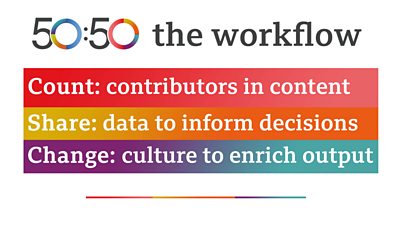50:50 is a voluntary, self-monitoring system designed to fit into existing workflows. It is simple and flexible, with a methodology founded on three core principles.

Collect data to drive change
Editorial and production teams monitor their own content and use that data to set benchmarks and track progress. Data is gathered at the time of production to increase engagement and encourage teams to make 50:50 part of their regular editorial conversations. Teams then share monthly data with the rest of the ����ý in a spirit of positive competition and collaboration.
Measure what you control
We only count the contributors that we control. In news content, we do not count people who are integral to the news stories of the day. For example, we do not count the Prime Minister when giving a speech or the only eyewitness to a bomb. We cannot tell the stories without these people, and we have no control over who they are. Everyone else counts – reporters, analysts, academics, experts, case studies and anyone who appears in our original journalism and features. If a contributor appears multiple times in a single programme or piece, they will only count once. Everyone who does count, counts as one.
No compromise on quality
The best contributor is always used, regardless of their impact on a team’s 50:50 numbers. Editorial excellence is always the priority. The 50:50 Project aims to help content-makers discover new voices to better reflect the audiences they serve.

COUNT contributors in content
Teams monitor the numbers of contributors in their content to set benchmarks for their chosen diversity measures. They then count regularly as their content is produced to track their progress against the benchmarks. The data is based on the perception of the person counting as to what the audience would see, read or hear.
SHARE data to inform decisions
Teams continually share and discuss their 50:50 data to inform regular editorial decisions. They aim to reach targets (e.g. 50% women contributors) over a period of time, usually a month.
CHANGE culture to enrich output
The longer teams monitor and share data regularly, the more likely they are to create cultural change. 50:50 has enabled teams to identify topic areas where women or other diversities are under-represented, such as science or sport. It has also given content-makers further encouragement to think differently about the stories they choose to tell, and to continually seek new voices and different perspectives to enrich their output.
Tailored approach
What teams count depends on their output. As a result, data from different teams is not always directly comparable and each team aims to improve upon its own performance.
Datasets
Some teams record multiple aspects of their output and submit separate figures for each measure. Each measure is one dataset.
Benchmarking
We ask teams not to change their behaviour in their first month of monitoring. It gives them a true understanding of the existing diversity of their output. This also gives them baseline figures to improve upon.
Monitoring gender identity
Content-makers monitor the gender identity of their contributors with the aim of featuring at least 50% women. They do not monitor whether a contributor’s gender differs from their sex registered at birth.
Where possible, teams will also monitor the proportion of contributors who identify as non-binary or genderqueer in order to improve their representation of all genders.
Perceived and Actual Monitoring
The majority of ����ý teams monitor by perception, relying on what they know of the contributor and any publicly-disclosed information. This ensures that 50:50 remains manageable and sustainable for busy teams, whilst also allowing us to gain a good understanding of what audiences will be seeing, hearing and reading.
In certain cases where content-makers have direct access to every contributor, they will record how contributors self-identify with the use of diversity forms.
Monitoring Disability and Ethnicity
Teams monitoring disability and/or ethnicity representation in their content can do so in one of two ways. Some collect simplified data on the overall representation of black, Asian and minority ethnic, and/ or disabled contributors. Others collect more detailed data, breaking the categories down further into groups that are relevant to that output’s target audience demographic. This data is not reported to 50:50 The Equality Project, but is used by the team to better inform their editorial decisions.
All our methods for monitoring and data capture comply with UK Data Protection Law.
Targets
In general, ����ý teams works towards the Corporation’s diversity targets of 50% women, 20% Black, Asian and Minority Ethnic and 12% disabled representation. International, regional and local teams adjust those targets in line with their particular audience demographics.
Partner Data
Partner organisations who monitor multiple datasets submit their 50:50 Challenge data in one of two ways. A number of partners choose to submit the average percentage of women featured in their content across the organisation as a whole, while others submit the individual results for each dataset separately.
To ensure this data is comparable and consistent, the average representation of women for each organisation is used in this report’s challenge findings.
-

����ý stories
See how ����ý teams have increased representation in their content -

50:50 The Pitch
Showcasing students' diverse creativity and work -

New Voices
More diverse voices in ����ý content -

Contact us
Got a query for the 50:50 team? Get in touch
